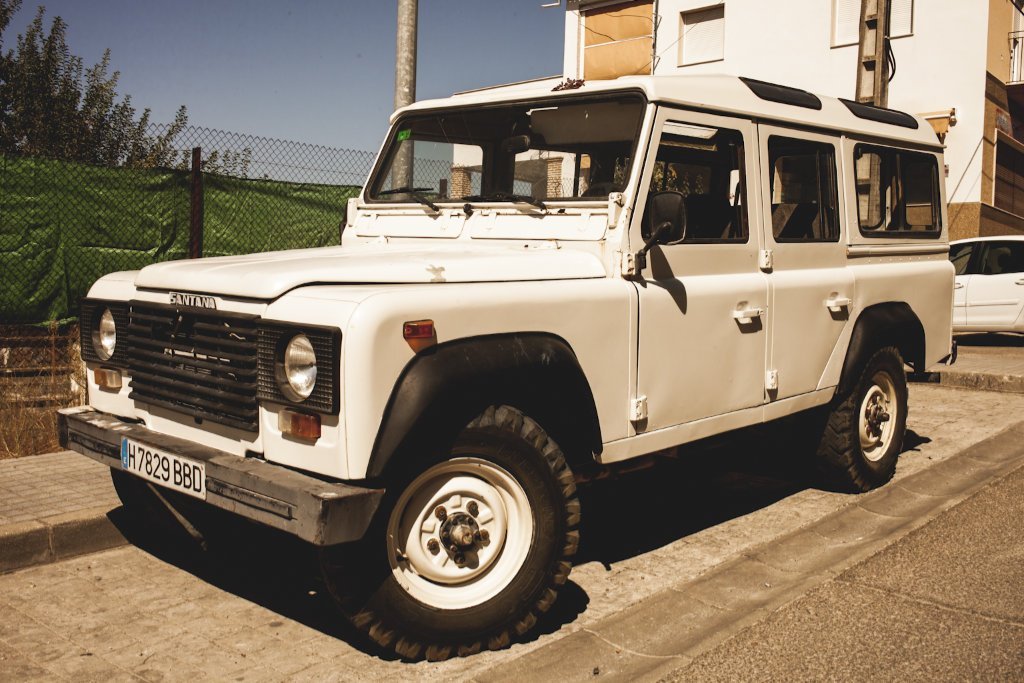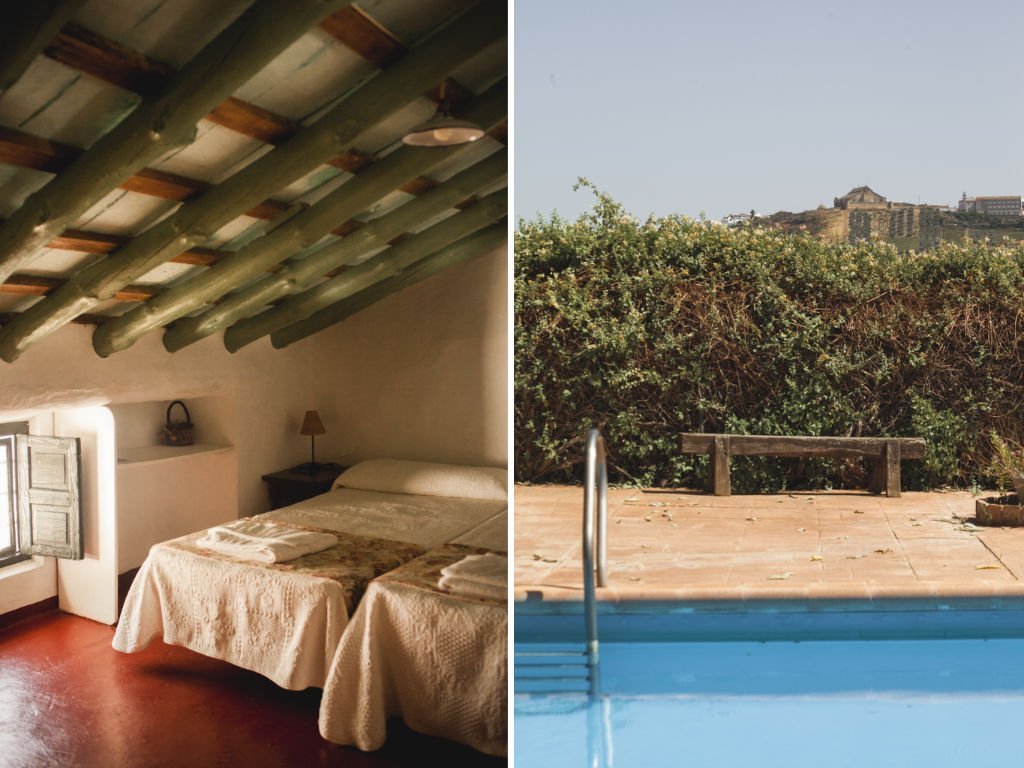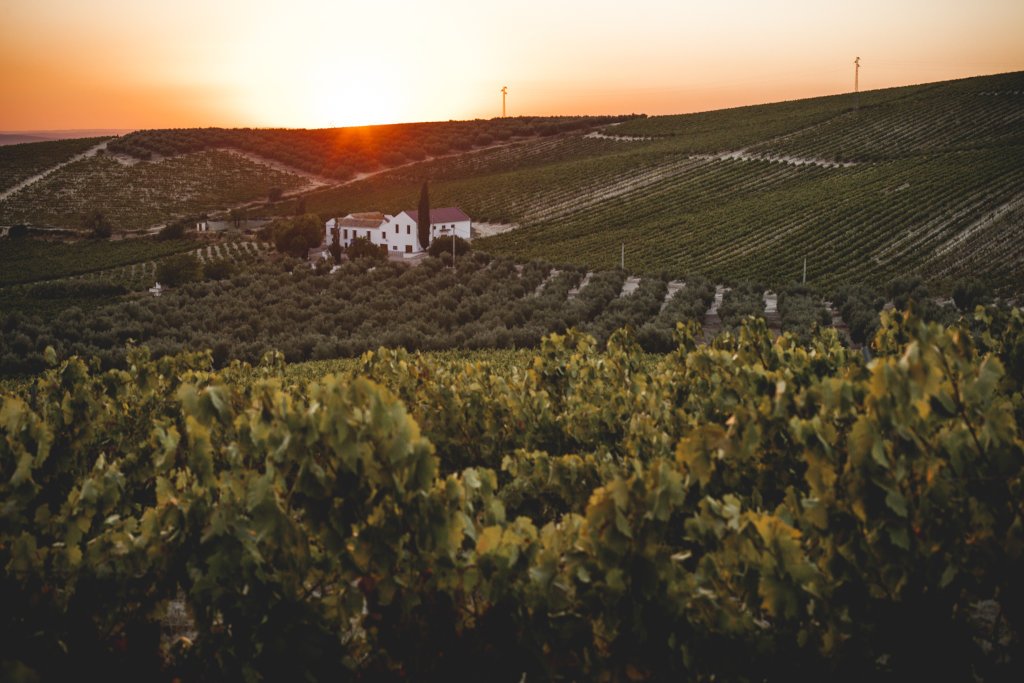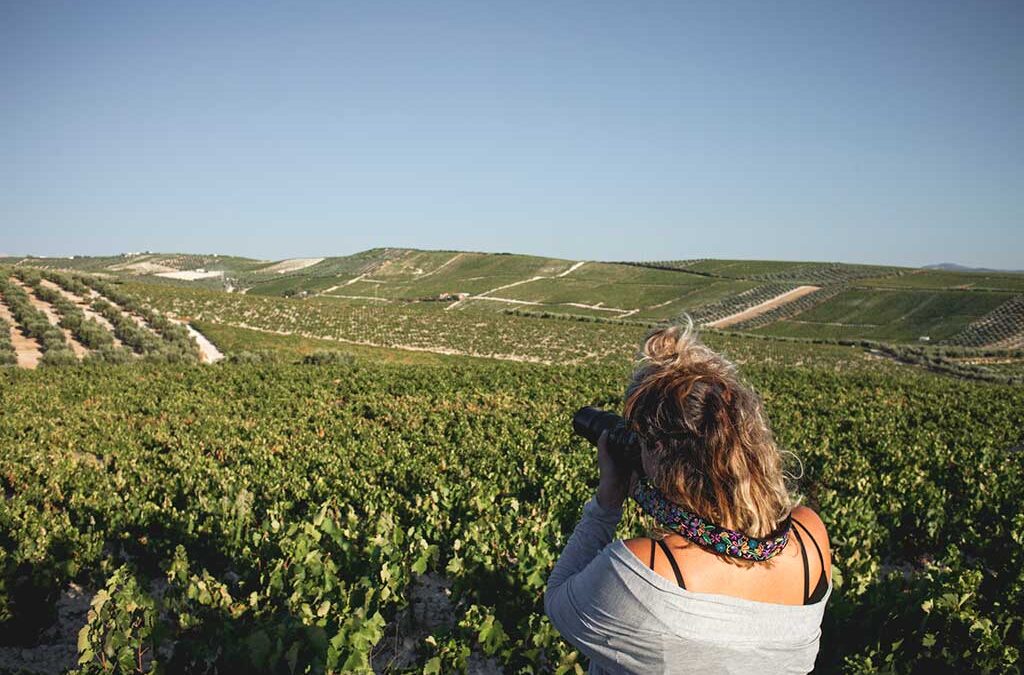WEEKLY ROUTE
Montilla-Sierra de Montilla-Moriles Alto
Text: Mara de Miguel @by_marademiguel | Traslation: Cristina Hodgson @cristinahodgson | Photography: Javier Portero @estudio.casa.palop | Main picture: You are going to take your memory card full with these lanscapes of the Sierra de Montilla.
Reading time: 5 minutes
This photographic route travels through some of the most beautiful landscapes and scenery of the Montilla Moriles grape harvest, the first to start in the entire Northern Hemisphere.
Every excellent wine has its genesis during the grape harvest. A superb wine is only possible with quality raw material, and although it may seem obvious, the harvesting of the grapes in the 17 municipalities of the Montilla Moriles wine region is unique. And today we want to experience it with a photo tour through the Montilla Moriles region, capturing people, places, moments and sunsets.
SATURDAY MORNING
We begin our photographic route.
It is 7:00 am on a typical day at the start of September. The sun has been out for a while, a moment grape-pickers savour the last taste of the wine, easily forgotten by others. This will be the first photo we take. One of those rituals performed by people in the region as they prepare to go to the fields.

It is 6.30 in the morning and this is how they prepare to go to the fields.
Everywhere in the winemaking world they are talking about veraison, when the grapes begin to ripen, while here in Montilla, possibly one of the earliest harvests in the entire Northern Hemisphere, the onset of ripening began a few weeks ago.
We walk around and photograph one of those white limestone soil plots that seem to be painted white, with chalk, on one of the hillsides that receives light almost all day long. Here Winkler’s V scale (a technique for classifying the climate of wine-growing regions based on heat summation or growing degree-days) reveals that the region it is one of the warmest areas globally and as such, the grapes ripen earlier.

At 9:00 a.m. It’s as bright as midday.
While in France they are crossing their fingers for a little more light, in Montilla Moriles there is plenty of light and heat for the ripening of the fruit. At this hour, the temperature permits photos to be taken comfortably.
Right now there is a slight breeze, a respite to the large clusters of white grapes of the Pedro Ximénez variety which have lulled while the sun slept. However, in a few hours, the temperature will rise again. Here, it’s a daily race against the clock to prevent the difference between the temperature of the clusters when they are cut and the temperature when they arrive at the winery from becoming too abysmal. At 13:30 it can be about 40ºC which does not facilitate the temperature control process for wine production. Fortunately, at that time we will already be in a cooling tavern.

No, we are not in Africa. This Land Rover model is the most typical in this area.
Taking pictures between tractors and off-road vehicles
We get into the car. An old 4×4 Land Rover, convertible, not forgetting the straw hat to cover our heads, the uniform of the grape pickers in this area. The sun, the breeze and that smell of limestone earth invades everything, mixed with the diesel of the compact pasqualis tractors and the must. No matter how much care is taken when tipping the buckets, crates or baskets into the trailer, some grapes are always inadvertently crushed.
We are in an area known as Cerro Macho, believed to be the true centre of Andalucia and the highest in the whole Montilla Moriles region, about 700 meters above sea level. And yes, that smell of limestone and the stamp of the people who work in such harsh conditions on these lands, makes this harvest unique. Incredible images abound.

These landscapes of the Cordovan countryside deserve to be captured.
We set off to another of the region’s superior quality areas, the Pagos Altos de Moriles, where we climb up to look out over the Cordoba countryside from a spectacular viewpoint. As well as the vineyards of the nearby Bodegas Lagar El Monte, we also stop to see a groove cut in a wall topped with brushwood, revealing what they call here the soils of albariza (a laminated type, like a deck of cards). Permitting a better understanding of this remarkable soil and the roots of these vines, which are true survivors.
Neither château, nor Portuguese quintas: Here in Montilla Moriles there are Lagares
We continue with our route, although we have to be patient because of a queue of tractors which are already starting their journey to offload the first kilos of the day at the presses. If France has the famous château, Italy has azienda, in Portugal there are quintas and ranches in California, here, in Montilla Moriles there are lagares. The lagares are half-wineries and half typical country manor houses with a patio. The whitewashed walls are surrounded on the four sides by the land where the grapes, from which the wines are made, grow. They were originally built with the purpose of delivering the newly cut grapes to the press as fast as possible.
Technology has become a great ally. Practically all wineries have modern systems for destemming, crushing and pressing and, once the pulp or must has been extracted, infallible temperature control systems stabilise it. Quite a spectacle to capture with the camera lens.

This is how they take care of themselves in Moriles. At the La Solera Tavern, the Vino en Rama wine is the protagonist.
And as it’s not just about admiring the landscape, to refresh yourself, a glass of Vino en Rama, in the tavern La Solera in Moriles, makes for another unique experience. Tony will serve you a wine straight from his own barrels (casks) without filtration or treatment which pairs with Iberian products, meat… in an unmatched combination of authentic flavours.
It’s harvest time and all over the city you can smell the wine fermenting in the clay vats that have of late become fashionable, especially with natural wine snobs, but which have always been used in the Montilla Moriles region.

At Finca Buytron, take a dip and relax surrounded by organic vines.
SATURDAY AFTERNOON
The best sunset among vines
In the afternoon we take a well-deserved dip in the pool at Finca Buytron, where we stay. This charming corner surrounded by vineyards, with unique views of the Montilla Castle, is dedicated body and soul to wine tourism. At present it is run by one of the most outstanding oenologists in the area, meaning that excellent wine and first-rate oenological experiences are guaranteed. And after a few hours of rest, we set off for the last stop of our photographic tour: To watch a spectacular sunset in the heart of the Montilla mountains.
But before, we pass by a rocky outcrop known as Piedra Luenga, a singular mass of rock that juts out among the landscape of olive trees and vineyards, drawing attention. And then, we finally reach the Sierra de Montilla and our destination, the Finca Cañada Navarro, which is possibly one of the best places to watch a sunset among the vines, and what better way to do it but with a toast to the sun as you say goodnight.

The best sunset in the Sierra de Montilla is viewed from the Lagar Cañada Navarro.
In this idyllic place where the birds swirl around the old elm trees, planted by a girl, who is now one of the adult guides at the press, on her way back from school. The birds, like us, create a cheerful chatter, and the cicadas also accompany us with their peculiar sound.
The last photo precedes the first glass of wine and we all toast by commenting on the magnificent views that will remain etched in our minds forever.
USEFUL INFORMATION
WHERE TO SLEEP:
Buytron Farm. Road Córdoba – Málaga, N-331, km 43, Montilla; tel 630 76 88 77.
This charming rural house is rented in its entirety, minimum 5 of its 8 double rooms. In high season (Christmas, Easter, July and August) minimum 4 nights and 6 rooms; price from 32 euros/person/night. This enchanting rural house, immersed in a deep reconversion, is surrounded by ecological vineyards of Pedro Ximénez grape, a swimming pool with spectacular views to the Castle of Montilla and quaint corners where to unwind and connect with nature. The estate also has an important historical element and a special link with the wine world of the Montilla Moriles region. Its owner, Rocío Márquez, is a respected biologist and oenologist and offers numerous experiences related to wine.
WHERE TO EAT:
La Solera Tavern. Calle Lucena, 43. Moriles; tel. 653 28 61 17.
A pilgrimage to this cosy tavern-wine cellar, also a wine shop, is a must for wine lovers. The star of the house is its Vino en Rama, that Tony himself, well known in the Moriles wine world, extracts for you from under the veil of flor of one of his 50 barrels. Here, quality and simplicity prevail above all. His excellent Vino en Rama, without chemicals, nor filtrations is usually served in a glass jar, which pours for three or four glasses of wine, very refreshing and accompanied by a plate of black pudding, cheese that he cures himself, and spectacular bacon, for €14. Don’t forget to try his delicious preserves, salmon ingot or his tomato with ventresca.
WHAT TO SEE:
Lagar Cañada Navarro. Cerro Macho region in the Sierra de Montilla; tel. 677 49 43 66.
Watch the sunset whilst sipping a glass of wine and enjoying a late evening dinner, minimum 5 people, from 12 euros/person, children welcome. Located at almost the highest point of Cerro Macho, considered the superior quality area of the Montilla Moriles region, this lagar is not only the oldest and the most authentic of the many lagares found in the Sierra de Montilla, but it is also offers views of one of the best sunsets. Owner, Santiago Jiménez, proud advocate of the area, will tell you the story of his family linked to this living wine museum. A tour of the grounds and the wine tasting can be done after sunset, with alfresco dinning under the large elm tree.


